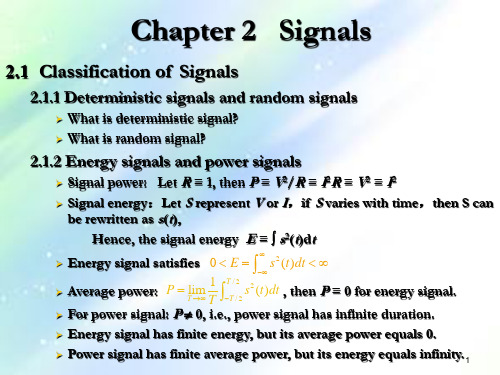通信原理讲义-英文版
- 格式:ppt
- 大小:2.51 MB
- 文档页数:45

通信原理英文Communication PrinciplesCommunication principles refer to the fundamental concepts and theories that govern the process of transmitting information from one entity to another. These principles form the foundation of effective communication and play a crucial role in various communication systems, such as wireless communication, optical communication, and digital communication.One of the key communication principles is the concept of encoding and decoding. Encoding involves converting the information into a suitable form for transmission, while decoding involves the reverse process of converting the received signals back into meaningful information. This principle ensures that the information is accurately transmitted and understood by the receiving entity.Another important principle is the concept of modulation. Modulation is the process of modifying a carrier signal by varying its amplitude, frequency, or phase to carry the information. This principle is used in various communication systems to transmit information over long distances without significant loss or distortion.Furthermore, the principle of noise reduction is crucial in communication systems. Noise refers to any unwanted disturbance that affects the quality of the transmitted signal. To ensure reliable and clear communication, noise reduction techniques, such as filtering and error correction, are employed to minimize the impactof noise on the received signals.Additionally, the principle of multiplexing allows multiple signals to be transmitted over a single communication channel. This is achieved by dividing the channel bandwidth into smaller sub-channels, each carrying a different signal. Multiplexing enables efficient utilization of the available communication resources and allows for simultaneous transmission of multiple signals.Furthermore, the principle of synchronization is essential for successful communication. Synchronization ensures that the transmitting and receiving entities are operating in a coordinated manner, allowing for accurate transmission and reception of the information. Various techniques, such as clock synchronization and frame synchronization, are employed to achieve synchronization in communication systems.Lastly, the principle of error detection and correction is crucial for reliable communication. Error detection techniques, such as checksums and parity bits, are used to identify errors in the transmitted signals. Error correction techniques, such as forward error correction codes, are employed to correct the detected errors and ensure accurate transmission and reception of the information. In summary, communication principles are fundamental concepts and theories that govern the process of transmitting information. These principles, such as encoding and decoding, modulation, noise reduction, multiplexing, synchronization, and error detection and correction, ensure efficient and reliable communication in various communication systems.。




![通信原理(英文版)11[63页]](https://img.taocdn.com/s1/m/e0c876856f1aff00bfd51e3d.png)








⽆线通信原理双语讲义第⼀⼆讲Course Code: B020305Course Title: Wireless Communications Principle and Practice (T. S. Rappaport 2004) Academic Year : 2015 Semester: 2Lecturer: Gao Huanqin (Room1610), College of Commu. and Inform.Engineering,NJUPT Lectures: 32 hours, lectured in English partially.E-mail Address: gaohq@/doc/e24373aa26fff705cc170ad9.html .au前⾔Preface (PP:1)本节课是本课程的第⼀堂课,介绍课程的相关信息;讲授第⼀章教学内容“⽆线通信概述”,它涉及英⽂教科书的第⼀、第⼆章内容。
Content(教学内容)s: Provide fundamental treatment about many practical and theoretical concepts that form the basis of wireless communications, especially fundamental cellular radio concepts such as frequency reuse. Propagation path loss prediction models for cellular networks, multiple access method. ⽆线通信基础相关的基本理论、概念与应⽤,突出基本概念与基础理论,例如蜂窝⽹中频率复⽤。
基础理论例如传播路径损耗预测模型,多址接⼊技术等。
Objective of the course(教学⽬标): After the course the student has a good basic knowledge of cellular and personal communication systems and the systems evolving from it. Also, the student will get a basic knowledge of the design of cellular networks and understand the special requirements, which result from the mobile radio environment. 通过本课程的学习让同学了解⽆线蜂窝通信系统的基本概念、基础理论以及系统演进,了解移动⽆线环境下的蜂窝通信⽹络系统的设计及需求。



